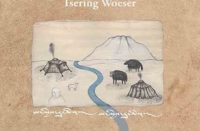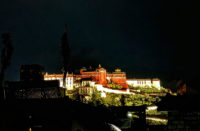High Peaks Pure Earth has translated a blogpost by Woeser that was originally written for broadcast on Radio Free Asia on September 1, 2010 in Beijing and posted on her blog on September 8, 2010.
In this blogpost, Woeser refers to recent incidents in Tibet involving protests against the extraction of natural resources such as mining. Photos of the protest that occurred in the Shigatse area in May 2010 that were sent to Radio Free Asia at the time were re-posted on Woeser’s blog, follow this link to see the photos that Woeser refers to in her blogpost.
More recently, there have been various reports of protests in eastern Tibet in August 2010 in which several Tibetans were shot dead, at least four according to this report by Radio Free Asia. However, official Chinese state media have only reported one death, read the Xinhua article “17 police injured, one Tibetan dead in dispute” here and the Associated Press report “Police accidentally killed Tibetan” here.
![]()
![]()
![]()
![]()
“‘Avatar’ in Tibet”
By Woeser
Exploitative behaviour and the fight against it, as shown in the blockbuster film “Avatar”, has become more and more common everywhere in Tibet. What I am referring to are ruthless mining activities disguised as economic development which have led to local Tibetans having to sacrifice their basic rights to live and which have gone as far as Tibetans being shot by armed police for petitioning. This is what happened on August 17 in the Kham region of eastern Tibet, a region that can be compared to the beautiful world in “Avatar” in terms of its scenery and natural resources. Today, that region has been administratively determined as the Pelyul County of the Kandze Tibetan Autonomous Prefecture of Sichuan Province. According to accounts by locals, several hundred Tibetans had gone to the local government building and called for an end to mining activities, a protest that ended in bloodshed; at least 3 people were shot, more than 30 injured and many were arrested.
Because this event was covered in the foreign media, recently, Xinhua news agency actually admitted that these protests had occurred and that some Tibetans had been shot dead. However, they reported a fantastically different version of the story. Not only did they argue that the local authorities were entirely innocent in this matter, they also claimed that local Tibetans had violently attacked the police forcing them to fire warning shots, which caused the accidental death of a Tibetan who was hit by a bullet. Their reason for why this incident had occurred in the first place was even more ridiculous: the Tibetan protesters had not been calling for an end to mining activities, instead they had requested a local Han Chinese gold miner, who had been arrested for destroying grasslands, to be set free. This really does not make any sense; a story with this many loopholes will never convince anyone. The authorities are hardly able to justify themselves, yet, they grandly present to the world this ridiculous story; do they think everyone in this world is just stupid?
I have been to Pelyul County; it is a remote place, difficult to access and surrounded by steep mountains and rapid rivers. At each of the two entrances are protective tollgates making it almost impossible for any outsiders to enter. So it is very difficult for outsiders to know what actually happens inside. For example, in 2008, in many Tibetan regions, war-like massacres took place, which were never known to the outside world. Herdsman wrapped in sheepskin robes were riding horses, shouting “ka hee hee” instigating an uprising and were strafed by military police using modern weapons. An armed policeman who had been sent to Litang from Chengdu later posted photos of new handheld machine guns on the internet proudly writing: “it blows off the heads of any thugs within the range of 100 metres.” By thugs he meant the unarmed and defenceless Tibetans and the only reason why their heads were “blown off” was that they took to the streets and raised their voices in protest.
But let us not mention the never dissolving bloodstains from two years ago. In actual fact, it is just like those indigenous people in “Avatar”, who, with their own flesh and blood, had to fight against the weapons of the mercenary army trying to seize their homeland. For many years now, this is the Tibetan people’s story: Tibetans have experienced this themselves for many generations.
I still want to talk about similar events that occurred in Kham region’s Pelyul County. Earlier this year, on May 21, some Tibetans from Sokchen Village in Namling County of Shigatse Region went to the village government to protest against a mining company from Weifang, Shandong province, arguing that mining causes ecological damage, drinking water pollution and problems for cattle etc. The local authorities sent a thousand military policemen to cope with those “emancipated serfs” who petitioned carrying the Chinese flag (see image 3, above), some Tibetans were beaten up, many were arrested.
Someone at the scene took photos and sent them to the Tibetan service of Radio Free Asia; I would like to pay my respect to the courage of this person. On these photos we can clearly observe a very ironic reality: the Chinese government claims that fifty years ago, it “liberated” the “serfs” living a life in misery and ever since, “tens of thousands of emancipated serfs” have been living a life in happiness which has been the best period in Tibetan history ever and so on and so forth. Yet, the photos show “emancipated serfs” being forced to kneel on the ground, how is it possible that the army that “liberated” them is now approaching them with strong weapons? Or maybe those elderly, those women and good-natured herdsmen are all secret “splittists” of the village? If these people are really “splittists”, maybe the reasoning about the past 50 years of a “liberated” life in “happiness” is not convincing!
Beijing, September 1, 2010




Follow Us!